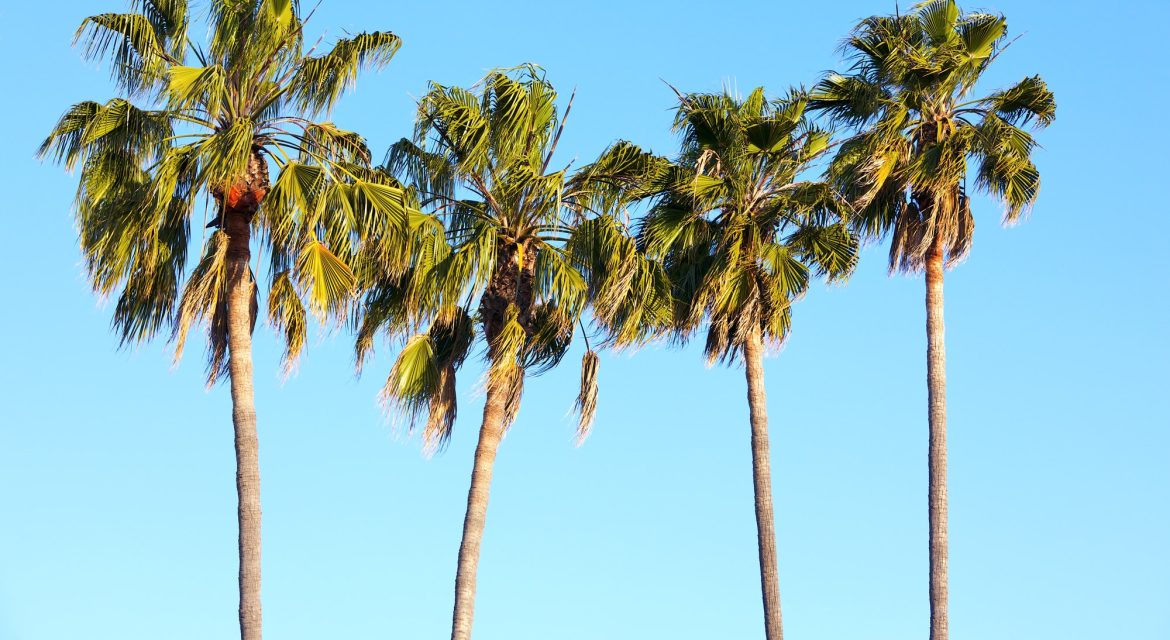What kind of palm tree should I plant?
There are several factors to consider when choosing a palm tree for your landscape.
Many of us want to plant the largest and most beautiful palm tree we can find. You need to realize all palm trees will not survive your climate. Most palms cannot take extreme conditions or some even a light frost. Cold temperatures can weaken your tree and encourage insects to your palm tree their new home and eventually kill your beautiful tree. Before investing your money in a palm tree check with a reputable company or an expert and not just a local center that hires people that have no idea of what they are selling.
Size is another factor to consider when planting a palm tree. A small palm tree can grow to over 60 foot at maturity and may have to be removed if it interferes with your view, overhead lines, under-ground lines or too large for your landscape.
The specific requirement of sunlight needs for proper growth of your palm depends on the specie you choose. Some palm trees do best in shade, others direct sun, and some prefer shady conditions when young and sun when they’re older. This is very important to consider when buying your tree. Too much sunlight can burn their leaves. your palm and prevent it from growing as it should and even worse make that beautiful landscape you are trying to design unsightly.
This is one of the most problematic issues for palm trees that I have seen. All palm trees do not have the same requirements. Palm trees can grow in the desert and require very nominal amounts of water, while others can grow in the swamp. If planting a new palm in your landscape make sure you know the water requirements. We suggest keeping the root ball damp for the first couple months while it acclimates. Some palm trees are dug out of the ground and the roots are severed and the roots will need to regrow from the base of the tree and will need to receive an adequate amount of water.
Most palms are from tropical and sub-tropical regions, but many areas have particular micro-climates which allows for a more diverse selection of palms that you can grow. Many palm enthusiast who live in marginal areas or have a micro-climate like to ‘zone push’, which is testing the limits of a palms known tolerance. Check our Zone Map to determine your zone.
Field grown palms are either sold potted (in a pot) or ball and burlap. Try to keep your root ball damp until it is planted. The best time to plant a palm tree is early spring after the last frost and ground temperatures are around 65 degrees Fahrenheit.
If your soil is mainly sand it will be fine to dig the hole wider than the root ball and mix 1 part sand and 2 parts compost to backfill the hole. If you are planting in mainly clay ground I suggest not digging the hole much wider than the root ball and actually not as deep. If you dig a big hole in clay and backfilling with sand/compost mixture you are actually digging a big bowl for more water to stand. This can cause root rot or other health issues for your palm tree. If you dig your hole too deep and add loose dirt back in the hole make sure you water your newly added dirt and tamp down before adding your palm tree. If you add fresh dirt to the bottom of the hole and place your palm on loose dirt and the dirt then gets wet the palm will settle and be lower than it should be. This can actually kill your palm. After backfilling your hole use the handle of your shovel and make sure any large air pockets are out and then tamp down with foot. Build a small berm around the circumference of your palm and water in.
Watering is crucial for the survival of a newly planted palm. Make sure the root ball is kept damp, but not soaked during the acclimation period. Water for around three weeks and then tapering off for the next three months. This should give the palm a great start on establishing itself in your landscape
Palm Trees also require periodic fertilizer applications. There are commercial mixes available especially for Palms.
Palm Trees require specially formulated fertilizers that answer to very specific conditions and is another important component of palm tree care. Palm fertilizer has micronutrients that palm trees need for proper growth and to keep your palms healthy. Palms benefit from fertilizer that is in the 3-1-3 ratio of nitrogen, phosphorus and potassium. When you apply fertilizer apply it at the drip line of the fronds. A sick tree becomes subject to insect damage and becomes weak. A palm that has been cared for and fertilized properly will be more likely to survive bad weather conditions. You should fertilize your palm two or three times a year. Some people like to add mulch around the base of their palms to keep the weeds down.
Most diseases are either mold or fungus. If not detected early enough could diminish the look or worse kill your palm. In some areas there are some palm diseases that are not treatable and your palm will die and is best to remove this palm as soon as possible to avoid the spread of the disease. There are many harmful organisms to palms and Lethal yellowing, Fusarium wilt, Ganoderma rot (root rot), Leaf spot fungi, Sooty mold, and Phytophthora root rot are among the most prevalent. You can find information on the treatments and causes of these and others online. Investigate early to keep your palm healthy and alive.





